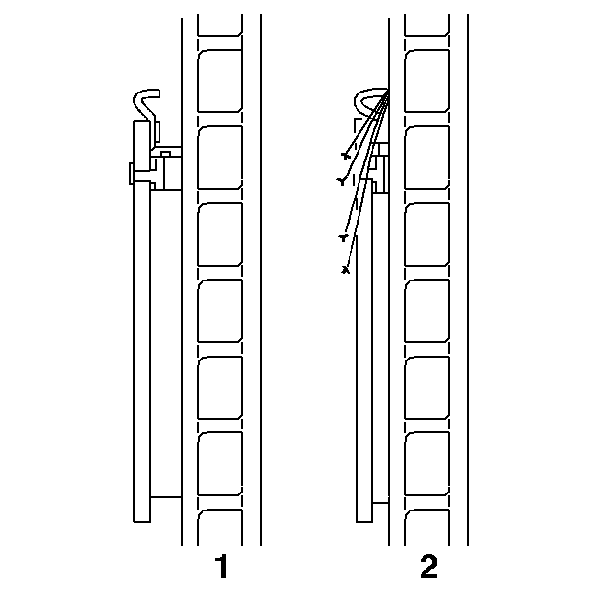The disc brake assembly consists of a caliper assembly,
rotor, linings, anchor plate, and pads mounted to the steering knuckle. The
caliper mounts in a way that allows it to move laterally against the rotor.
The caliper is a one-piece casting with the inboard side containing the
piston bore. A square cut rubber seal fits in a groove in the piston bore
to provide a hydraulic seal and return mechanism for the piston.
Applying the brake pedal causes the hydraulic pressure that moves
the caliper piston. The piston then forces the inboard brake lining assembly
against the inboard braking surface of the rotor. Increasing the force against
the rotor causes the caliper to move inboard. The outer brake lining assembly
then contacts the outboard braking surface of the rotor. The force of the
two lining assemblies provides the desired clamping action on the rotor.
Releasing the brake pedal relieves the pressure applied on the piston.
The square cut seal on the piston relaxes and the seal allows a running clearance
between the brake lining assemblies and the rotor.
Servicing Information
| • | Replace all components included in the repair kits. |
| • | Lubricate the parts as specified. |
| • | Do not use lubricated shop air on the brake parts. Shop air can
damage the rubber components. |
| • | If necessary, bleed all or part of the brake system after any
hydraulic component has been removed or disconnected. |
| • | Replace brake pads, shoes and linings in axle sets only. |
| • | The torques specified are for dry fasteners, without lubrication. |
| • | Perform service operations on a clean bench. Verify that the bench
is free from mineral oil and other contaminants. |
| • | Use extreme care when doing any work around antilock components
in order to prevent damage or misalignment. |
| • | Pump the brake pedal several times in order to make sure it is
firm prior to moving the vehicle. Do not move the vehicle until a firm pedal
has been obtained. Check the brake fluid level in the master cylinder after
pumping the brakes. |
Front Brake Rotor
The front disc brakes use one of three different styles of rotors. Models
with a GVW rating of 7300 lbs or lower use standard 1.25 in
(31.750 mm) rotors. The heavy duty single wheel models, GVW 8600 and
9500, use standard 1.26 in (32.004 mm) rotors. Models with
dual rear wheels use a four piece rotor consisting of the rotor, the bearings,
the hub and the extension.
Front Brake Caliper
These models use three different type of front brake calipers. Any models
with 6100, 7100 and 7300 GVW ratings use the Delco 3400 series front brake
calipers with 75 mm (2.6 in) single bores. Any models with
8600 and 9500 GVW ratings with a single rear wheel design use the 80 mm
(3.1 in) single bores. Any models with a GVW rating of 10,000 and
above use the 86 mm (3.4 in) single bore. The front brake
caliper mounts to the steering knuckle using two bolts.
Check the flatness of the front brake pads. Place the inboard and the
outboard front brake pad surfaces together and check for a gap. The gap should
not exceed 0.13 mm (0.005 in) at the middle of the front brake
pad surfaces. This measurement applies to both new and used front brake
pad sets.

The front brake pads on all models contain wear indicators that contract
the rotor and make a loud scraping or squealing noise when the pads wear to
the point of needing replacement.

